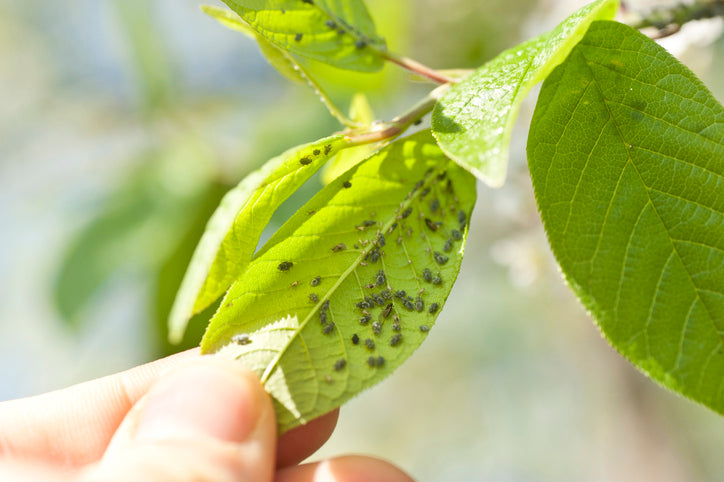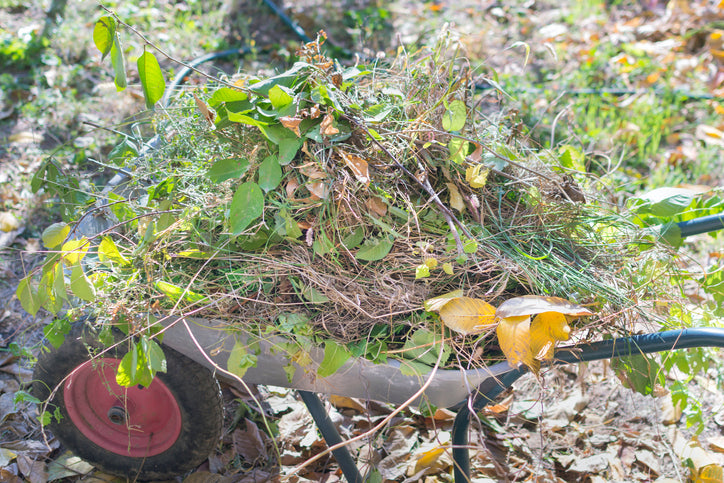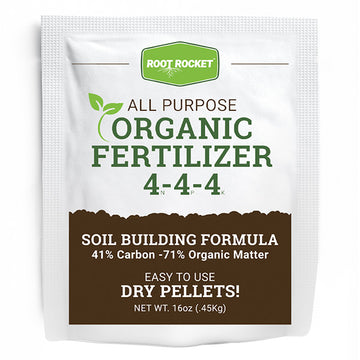There are many ways to protect your plants and reduce the risk of deterioration from pests and disease. Several of the best ways to prevent plant diseases and invasive pest infestations are natural. By performing some basic maintenance and care for your plants, they will become healthier. Healthy plants are less likely to be affected by insects and disease. There are a few good habits you can incorporate right now to help your garden or landscape stay healthy.

How to Protect Plants From Insects & Disease
1. Keep your landscape clean and free from debris.
This is an especially important task in winter, in preparation for spring when all the creepy crawlies emerge hungry from their winter slumber. Some insect eggs are dormant in leaves and other dead plant material lying around in your yard. Yard debris can also house fungal spores. Remove yard waste along with pests and disease with no chemicals or treatment needed. Proper maintenance of the space where your plants grow is one of the most effective steps in answering the question, “How can I protect my plants from insects naturally?” Piles of leaves, twigs or other debris leftover from weeding, pruning, or raking are a breeding ground for new life. Insect larvae, bacteria, and fungus love the warm, dark, protection of a pile of dead leaves or twigs. The process of organic matter decomposing provides the perfect opportunity for new insects, bacteria, and fungus to come into the world.
However, some insects, bacteria, and fungus help the health of your garden. Using the decomposing vegetable matter from your garden can be an excellent way to start mulch or compost. Because plant diseases and invasive pests can breed in decomposing organic matter, it’s important to keep your compost a reasonable distance away from your plants.

2. Water at the base of plants to reduce fungal issues.
Overhead watering can increase the likelihood of fungal infection in many plants.* If you must use overhead watering, do it in the morning rather than at night to ensure the water is able to evaporate off the leaves. Sound watering practices are some of the best ways to give your plants a boost in fighting diseases. Too much water could encourage the growth of fungus. Too little water, though, could cause your plants to struggle to stay healthy, causing a handful of other problems. If plants get insufficient water, they might cut off nutrition to some of their leaves, flowers, or fruit. This can cause parts of the plant to die and start rotting, which can attract pest infestations.
*For tropical plants that enjoy humidity, like citrus plants, overhead watering is encouraged.
3. Keep your plants healthy.
Pests and disease are more likely to attack weak plants. When you ask, “How can I protect my plants from insects naturally?” one of the most effective ways to deter diseases or insect infestations is to maintain the health of plants. Understand and implement the proper water, spacing, pruning, and fertilization requirements for your particular plants.
The first step is to make sure the soil is correct for your plants. It’s important to maintain the health of your soil by regularly testing the levels of acids and alkalines. In addition, crop rotation methods are effective measures against depleting certain nutrients and replenishing others. This might sound odd for a flower garden since flowers aren’t exactly crops. Still, some varieties of flowers or other garden-appropriate plants use up certain soil components, while others will renew nutrients in the soil. Crop rotation has been part of keeping plants healthy since before the invention of the sickle (the second earliest farming implement discovered through archaeology, after the plow).
Plants have many natural defensive adaptations, several of which are more effective than anything we can do for them. Keeping your plants healthy gives those natural defensive adaptations a boost in performance. If your plants aren’t fighting against too much sun or too little water or bad soil, they are more likely to be able to fight off diseases or fungal attacks. Work with your plants! Ensure that they’re getting the sun, water, and nutrition they like best.
4. Grow plants that deter and even repel pests.
Plants like chrysanthemum, rosemary, garlic, chives, and petunias repel unwanted insects that harm your plants. If you’re having trouble with deer eating your flowers, plant irises. Deer won’t go near them. While intuitively we assume that flowers attract insects, some plants release scents that repel insects.
5. Most natural insecticides only work when insects are present, but pepper spray can be effective in repelling some harmful insects.
Hot pepper spray can be an effective preventative measure in repelling insects. The chemistry behind the taste of pepper that we humans tend to like is unpleasant to many insects. However, in controlled quantities, hot pepper spray is harmless to many plants. Pepper spray can be an effective preemptive measure against an insect infestation. If you are wondering, “How do I protect my plants from flies?” Pepper spray might be the solution you need.
6. Mulch is a great way to reduce watering needs and protect your plant’s roots.
Mulch helps your plants receive the moisture they need without making the ground soggy. Apply mulch properly by keeping it away from the trunk or branches of your shrubs and trees. Do not put mulch all the way up to your home or foundation. Providing mulch helps improve the general health of your plants. It also helps prevent fungal diseases that thrive in too-moist environments. In addition, mulch supplies a home for beneficial insects that eat invasive insects.

7. Choose pest and/or disease resistant plants especially when you know of an existing problem in your area.
Seek out plants that are resistant to that particular issue. This is especially important with detrimental fungal diseases. Research the plants you would like to plant. Some strains or plant varieties will have stronger resistance to fungal attacks or plant diseases. Take your area into consideration when choosing what to plant.
8. Use products like Neem oil or fungicides to prevent any recurrent diseases.
Fungal infections can be difficult to eliminate. Prevention is the best course of action for this type of disease. Use pesticides to treat insects and miticides to treat mites. When figuring out how to protect plants from insects naturally, consider natural insecticides such as pyrethrins, Neem oil, soapy water, etc.
There are several products on the market that address invasive pest infestations and plant diseases. However, you need to be careful when shopping for these products and choose something that is safe for the plants. For a fungal, pest, and mite control all-in-one product consider Ferti-lome.
How To Protect Indoor Plants From Insects
Your indoor plants need protection too. You need to know how to get rid of bugs on indoor plants to protect them, the same way you protect your outdoor landscape. Here are a few tips:
- Quarantine any new plants you bring into your home.
- Wash pots before putting a new plant in them.
- Don’t overwater your plants and make sure they are getting enough sunlight to keep them healthy.
- Clean up fallen leaves.
- Inspect for pests regularly.
If you find pests on your houseplants, isolate the plant, wash the leaves, remove the bugs, clean the pot, and apply a natural insecticide.
Ferti-lome Protects Plants from Disease and Treats Insects and Disease
What is Ferti-lome?
Ferti-lome Triple Action Plus is an amazing dual purpose pest and disease control product that is safe to use on fruits, vegetables, and herbs up to the day of harvest. It is a miticide, pesticide, and fungicide three-in-one product. It contains pyrethrins and neem oil. Pyrethrins are naturally occurring pesticides that come from chrysanthemum flowers. They are effective against insects and much more gentle on the environment than harsh chemicals. Neem oil is also a naturally occurring product that comes from a tree. It is effective in preventing and treating fungal diseases. It’s also effective in treating plants for soft-bodied insect pests, as well as insect eggs and larvae.
What Plants Can I Use Ferti-lome On?
You can use this product on just about any plant! We recommend it for citrus, fruit, vegetables, nuts, herbs, flowering and evergreen shrubs, perennials, houseplants, rose bushes, and more.
Which Pests Does This Product Get Rid Of?
Ferti-lome kills all stages of ants, aphids, armyworms, beetles, cabbage worms, crickets, fleas, fungus gnats, Japanese beetles, leafhoppers, leaf miners, leaf rollers, loopers, mealybugs, scale, spider mites, squash bugs, squash vine borer, tent caterpillars, webworms, weevils, and whiteflies.
What Types of Fungus Does Ferti-lome Prevent and Control?
Ferti-lome Triple Action Plus is effective at preventing and controlling anthracnose, black spot, botrytis, downy mildew, flower twig and tip blight, leaf spot, mildew, needle rust, rust, and scab.
How to Apply?
Application is easy! Ferti-lome Triple Action Plus comes in an easy-to-use spray bottle. Shake well and spray the affected plant thoroughly, taking care to coat the undersides of leaves. Avoid use on stressed or wilted plants. For sensitive plants like ornamental olive trees and red maples, test a small area first. Avoid spraying the flowers of impatiens, fuchsia, hibiscus, and roses.
How Often Should I Apply?
For the prevention of disease, Ferti-lome should be sprayed every 1 to 2 weeks. If you know disease is present, use once weekly until the disease is under control. For best results, insect pests and mites should be treated in the earliest stages. For heavy infestations apply this product every 7 days. For minor bug problems use Ferti-lome every 2 weeks.
Be Safe.
Avoid inhaling this product. Keep it away from water sources as it can be harmful to fish. Even though this product is safer than most pesticides, use caution when applying it. Keep pets and children away from sprayed areas until they are dry.
Common Plant Pests and Diseases
Common Pests
Some insects are harmless, causing no meaningful impact on your garden one way or the other. Other insects are positive additions to your garden. Ladybugs and praying mantises hunt harmful insects such as aphids. Butterflies and bees pollinate your flowering plants. Before you attempt to eradicate insects you find in your garden, you should determine is it a pest, a friend, or harmless?
Some common pests include:
- Flea beetles - These insects chew holes in leaves and wilt plants or stunt growth.
- Aphids - They harm leaves, create a honeydew buildup that leads to mold, and stunt a plant’s growth.
- Spider mites - An invasion of spider mites dries out leaves, causing the leaves to die.
- Whiteflies - These tiny insects suck the juices off of a plant and cause wilting, stunted growth, and sometimes plant demise.
- Wireworms - Feeding on the roots of plants, these worms weaken plants at the root.
These are just a few common pests. Look for holes on leaves or bug infestations as warning signs of invasive pests.
If it is a pest, how can you get rid of it? Use a natural insecticide.
Types of Plant Diseases
There are as many different types of diseases afflicting plants as there are diseases that any other living organism can catch. There are plant viruses, molds, mildews, and more. Diseases like Rust, Clubroot, Leaf Spot Diseases, Verticillium Wilt, all commonly afflict plants. Identifying and treating the diseases early on is important to maintain the health of your plant. Each disease will have a unique treatment from applying fungicides to cutting back affected branches, etc.
Now you know how to protect your plants from insects and disease. Follow these tips to lower your risk of pests and disease. Treat your plants at the first sight of a problem. To prevent disease and control insects, mites, and disease check out Ferti-lome Triple Action Plus.
You May Also Like: Benefits of Citronella

